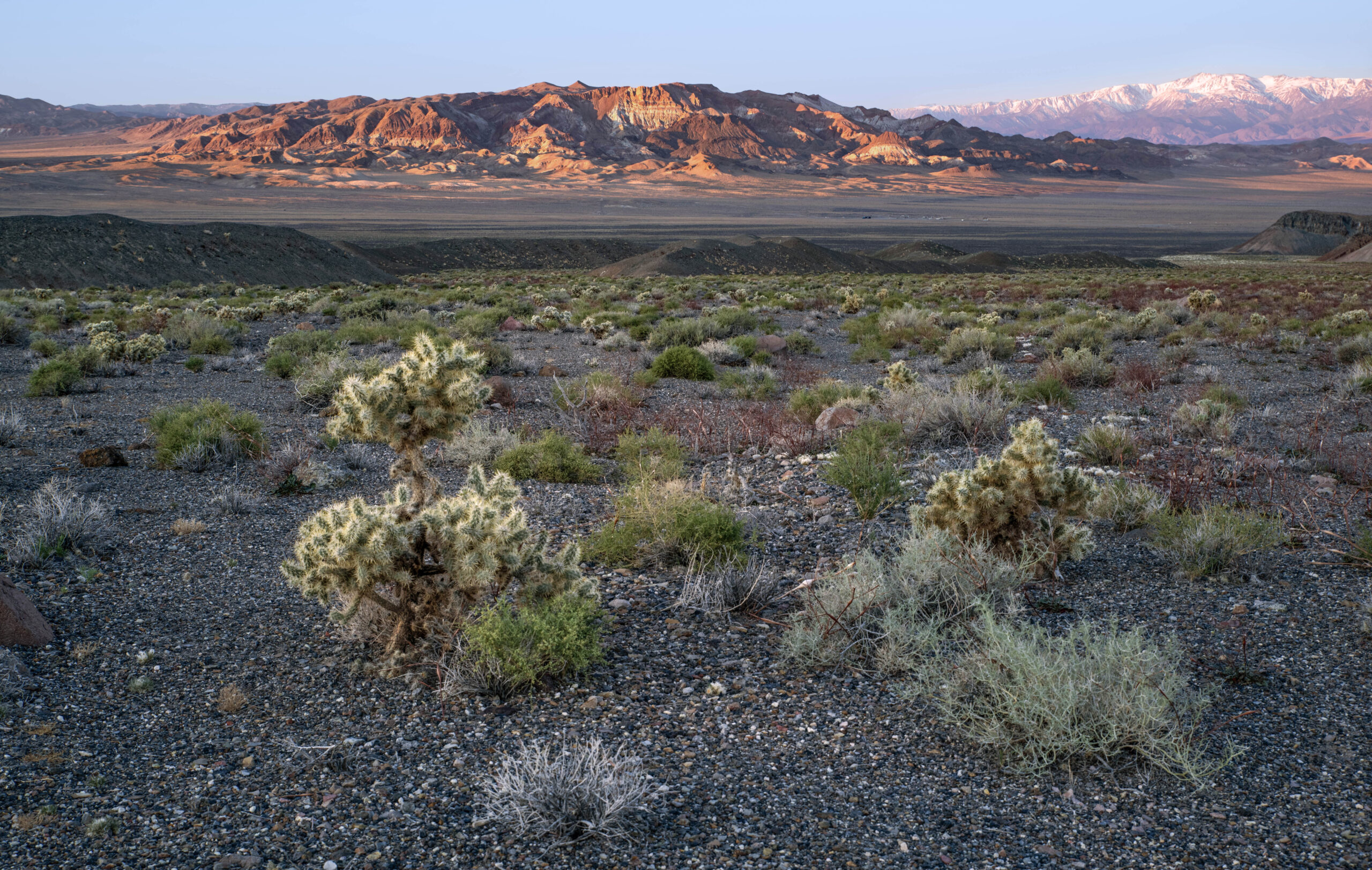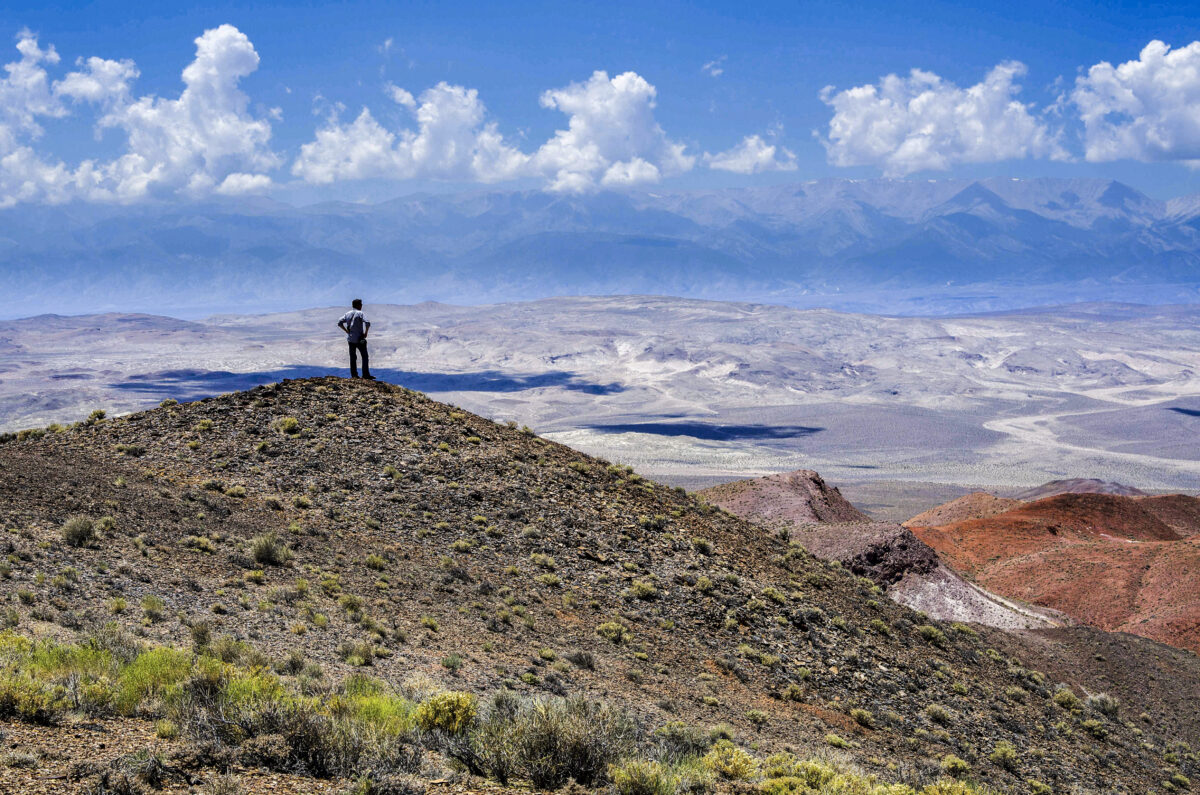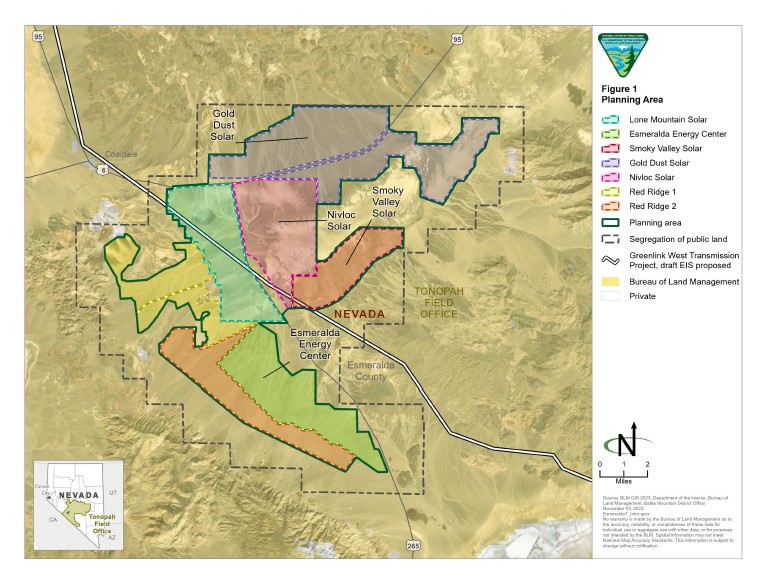Vegas-sized solar project could come to Nevada's smallest county; residents not thrilled

Esmeralda County is known for its vast swaths of rugged, undeveloped mountains and basins.
And that’s how its residents like it.
Fewer than 750 people — just one per every five square miles — call Esmeralda home, making it the least populated county in the state and the second-least populated county in the continental U.S.
There has never been a county manager to guide growth because, in a county almost wholly owned by the federal government, there is little land to privately develop.
But that rural and isolated lifestyle is now being challenged by solar developers seeking to construct a series of projects that, if built, would have a footprint nearly the size of Las Vegas.
The sprawling development is proposed for a 119,000-acre (or 185 square miles) swatch of largely undeveloped land 30 miles west of Tonopah, smack in the middle of Esmeralda County. The proposed site would cover more than 62,000 acres and would likely become North America’s largest solar project.
It’s an area celebrated by Friends of Nevada Wilderness because of its location near the pristine Monte Cristo Wilderness and its untouched natural beauty, once considered for a state park.
Now, Esmeralda County residents face the specter of trading in their dark skies and rural way of life for a sea of glistening solar panels. Because the project is proposed for federal land and could qualify for state solar tax abatements, some people at the county worry they will receive no financial compensation for the tradeoff.
“The county likes the idea of solar development. But … we want new development to pay its own way,” said Nancy Boland, a former Esmeralda County commissioner now serving on the county’s land use advisory committee and as a consultant to the county.
Esmeralda County residents such as Boland say they aren’t anti-growth — she and others have spoken publicly in support of the proposed Rhyolite Ridge lithium mine planned for the county. But the Esmeralda 7 project is hard to stomach, they say.
“We’re farmers and I know what 300 or 400 acres looks like in hay, and that’s big. This is enormous,” said Joyce Hartman, a former Esmeralda County commissioner who has called Dyer home for 53 years. “They are gonna take so much of the land and, you know, I think that our customs and culture are worth something.”

‘You don’t expect to come out here … and have to put up with this’
Across the West, the Bureau of Land Management (BLM) has earmarked “solar energy zones” — areas it sees as prime for solar development. The Biden administration has massively ramped up solar energy development on federally owned lands as part of its effort to combat climate change.
There are two such zones in Esmeralda County. The 16,500-acre Millers zone, 15 miles west of Tonopah, is traversed by a 120-kilovolt transmission line and the 4,600-acre Gold Point Solar Energy Zone is located 50 miles south of Tonopah and is near a 345-kilovolt line.
Esmeralda 7 is not planned for either zone.
Instead, it is proposed to be built flanking NV Energy’s controversial proposed Greenlink West transmission line, planned to run from Las Vegas to Reno. Advocates say the line is needed for grid resilience, while opponents say it will spur solar development — such as the Esmeralda 7 project — in some of Nevada’s wildest land.
Combined, Esmeralda 7’s individual projects have a 6,200-megawatt nameplate capacity — the maximum amount of power they could produce under ideal conditions. Actual output is expected to be less. A nameplate capacity of 6,200 megawatts is enough to power 2.5 million to 5.6 million houses.
Together, they will dwarf Gemini, Nevada’s largest solar project to date.
“Is it the largest in the world? We don’t know. Quite honestly, we wouldn’t go and research something like that,” Randy Martin, public information officer for the BLM’s Battle Mountain District, said of Esmeralda 7. “All we can say is what the planners, what the proponents say they will be doing.”
In its draft document outlining solar plans for the Western United States released earlier this year, the BLM projected the amount of land needed through 2045 for solar energy development based on a U.S. Department of Energy study exploring solar’s role in transitioning to a carbon-free electric grid. The BLM estimates that slightly more than 64,000 acres are needed in Nevada, 48,000 of them on BLM-managed land.
The Esmeralda 7 project alone more than covers that amount of land.
“There’s no comprehensive look at the impact of all this to the state,” said Shaaron Netherton, executive director of Friends of Nevada Wilderness.
Building a project such as Esmeralda 7 will require a workforce between 665 and 845 people per day, according to BLM estimates, with 50 percent of the workforce coming from the Las Vegas area or Southern California. Full buildout could take as little as five years, the agency estimates. After buildout, far fewer employees would be needed at the sites.
The influx of workers, even if temporary, and the metallic glint of the panels across dozens of miles of open desert will change the character of the county, locals say.
“If this is built, it’s gonna be really noticeable,” Boland said. “Your whole sense of freedom is going to be affected.”
The BLM acknowledges potential effects including changes to the visual landscape and quality of life, as well as increased noise, traffic and dust, in its draft environmental impact statement for the projects.
The sense of freedom Boland and other Esmeralda County residents value is being challenged more and more often across rural Nevada as the state’s public land becomes an attractive target for prospective solar developers.
“You don’t expect to come out here in the absolute middle of nowhere and have to put up with this,” said Hartman, the longtime Dyer resident.

Outdated resource management plans
Decision-making by the BLM is guided by resource management plans for each of its districts. The plans identify uses and restrictions for land, such as mineral extraction, recreation and wildlife habitat, and provide comprehensive management direction for all resources.
Nearly all of the management plans for Nevada are sorely outdated — most of them drafted more than 20 years ago. Some are nearly 40 years old. Solar barely existed when the oldest resource management plans were published, according to the BLM.
The Tonopah Resource Management Plan, which includes the Esmeralda area, was drafted in 1997.
“Congress has not been funding the BLM sufficiently to do the thorough and comprehensive planning that needs to be done on the front end,” Center for Western Priorities Policy Director Rachael Hamby said. “And now we need to rely on these plans … You have to do the best you can with the plan you have.”
Nevada BLM is working toward updating its resource management plans as one master document for the state, with a completion goal of late 2025 for the final environmental impact statement and records of decision.
“Let’s do the resource management plan for all of the BLM land in Nevada,” said Bertha Gutierrez, program director at Conservation Lands Foundation. “We need solar, and we need renewable energy to help us get out of the climate crisis … but it has to be done the right way. And that means in collaboration with the local community. That means in a responsible way. And that means providing appropriate mitigation measures.”

‘Lollipops called tax abatements’
Esmeralda County has the largest percentage of federally owned land in the state — 97 percent of the county, almost all of it overseen by the BLM. Of the county’s limited private land, roughly half is patented mining claims.
It is hard for the county to grow in any meaningful way, and generating funds with a limited property tax base is an ongoing challenge. This year, the county is working with an annual budget of only about $16.6 million.
Counties such as Esmeralda containing federal land receive payments in lieu of taxes — an attempt by the federal government to offset property tax losses incurred by the nontaxable federal land.
In 2003, Esmeralda County received $149,000 in payments in lieu of taxes from the federal government. By 2019, that had increased to just $350,000.
Some Esmeralda County residents worry partial solar tax abatements offered by the state could continue to hamper revenue.
Since 2010, the Governor’s Office of Energy has approved 54 tax abatement applications for renewable projects — utility-scale solar projects with at least 10 MW of capacity are eligible for a 55 percent tax abatement for two decades.
“The state hands out those lollipops called tax abatements, and if they do it with these solar projects, the county gets squat, and that’s a problem with us,” Boland said. “We don’t get any money from these people, and we don’t get any voice in where these things go. It’s really frustrating.”
A spokesperson for the Governor’s Office of Energy said no abatement applications have been submitted yet by the prospective Esmeralda 7 developers.
As dauntingly massive as Esmeralda 7 is, it isn’t the only large solar project planned for the county. The BLM is also considering three applications for solar and energy storage projects on 27,000 acres 35 miles west of Tonopah near Coaldale.
The projects — Candaleria Solar, a 500-MW solar and battery project; Esmeralda North, a 1,000-MW solar and battery project; and Cathedral Solar, a 1,500-MW solar and battery project — portend to span nearly 25,000 acres, more than 39 square miles.
Without a county manager, just three commissioners — De Winsor, Ralph Keyes and Rachel Holt, none of whom returned calls from The Nevada Independent — oversee the county's nearly 2.3 million acres.
With multiple solar and lithium projects, including Rhyolite Ridge, in various stages of proposal, the county’s tiny crew of staff and elected officials are struggling to keep up with the projects coming their way, Boland said.
“There’s too many of them,” she said.

‘People don’t know this is happening’
At the north end of the proposed Esmeralda 7 project is a mountain range most people have never heard of. Tucked deep in central Nevada, the Monte Cristo Range is a geologic playground of spires, arches and pillars in a rainbow of vibrant colors.
When Tonopah business owner Andrea Robb-Bradick saw it in 2006, she fell in love with the area and pushed for its designation as a state park.
Former Nevada State Parks Administrator David Morrow visited the site and agreed the unique geologic formations would “make a good state park” but questioned its financial feasibility in such a remote area. The BLM at the time also acknowledged the significance of the Monte Cristo Range.
Nothing ever came of her proposal.
Roughly a decade later, members of Friends of Nevada Wilderness mapped the area to look for areas with wilderness characteristics — undeveloped, roadless public lands greater than 5,000 acres that have maintained their natural character. The BLM is required by its own land policy to maintain an inventory of all public lands with such characteristics. They are separate from federally designated wilderness areas.
“We recognized what a threat solar and Greenlink (the NV Energy transmission line) were going to bring to that area. It’s totally undeveloped,” Netherton said. “Anywhere else, that area could have been a national park.”
According to the BLM, approximately 46,340 acres have been inventoried for wilderness characteristics in the planning area and just 2,260 acres were determined to meet the criteria.
“This isn’t a wilderness area,” Greg Helseth, renewable energy manager with the BLM, said during a November 2023 meeting regarding the Esmeralda 7 project. “A lot of land in Nevada has wilderness characteristics in it. This is not actual wilderness.”
Friends of Nevada Wilderness disagrees. According to the group, there are roughly a half million acres of land with wilderness characteristics in the area.
Last year, the group requested the BLM designate roughly 800,000 acres as an area of critical environmental concern, a designation that would invoke special management for the area. Again, Friends of Nevada Wilderness didn’t hear anything from the BLM.
Last month, the group filed a formal protest with the BLM against the proposed Greenlink transmission line that the Esmeralda 7 solar projects would tie into.
“The Biden administration is pushing green energy. They are jamming it down people’s throats,” Netherton said. “We need a lot of green energy now, and I’m on board, but there are some places it shouldn’t go. But it’s like ‘Hey, it’s Nevada, who cares.’
“We need to get the word out,” she added. “I think most people don’t know this is happening, and to the extent it is happening. We’re under siege here.”
Editor's note: This story has been updated at 8:47 a.m. on Aug. 26, 2024 to correct the estimated size of the solar project as measured in square miles.
